by Marie Arick | Mar 28, 2019
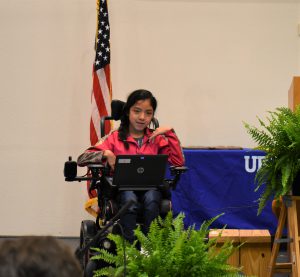
Tropicana Speech Contest
Liberty County 4-H’s Annual 4-H/Tropicana Public Speaking Contest included a special guest speaker with a uniquely delivered speech!
Ms. Delmy Pineda, a sixth grader at W.R. Tolar School, suffers from Cerebral Palsy. Delmy shared with her therapist, Kara Bradley, her desire to participate in the Tropicana Speech Contest. Delmy knew this was her last chance to participate being a sixth grader, so together, the two set out to make this happen.
So why is this so different? Delmy’s primary vehicle of communication is via a speech assist device. Yes, a computer-generated voice provided through a computer program. A first for any competitor.
Delmy wrote her speech, “Who Runs the World”, presented it and won in her class! Although she did not win in her school competition, Delmy embraced the opportunity and really championed the spirit of the competition. With that spirit in mind, the school administration asked if she could present at the County Competition as an honorary speaker. Of course, Delmy was added to the program without hesitation. Delmy presented her speech utilizing her speech assist device, a first for the Tropicana Competition. Delmy received a standing ovation. At that moment, Delmy was running the world.
For more information about the 4-H/Tropicana Public Speaking Program, or any other opportunities for your child, please contact your local UF IFAS Extension Office.
by Taylor Wilken | Mar 22, 2019
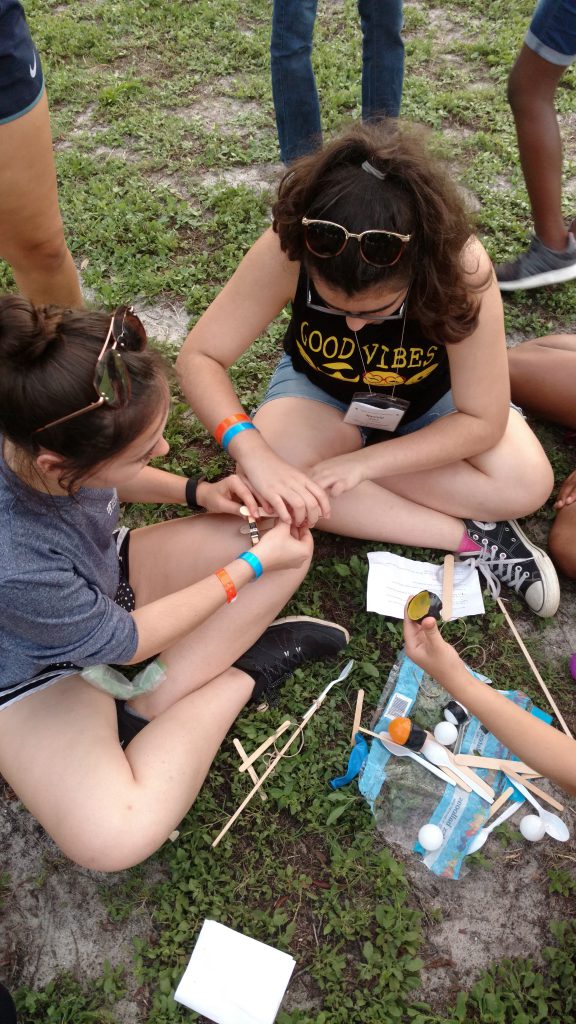 Summer camp…memories cherished and never forgotten. Camp fires, swimming, canoeing and kayaking, roughing it old-school in cabins and bunk beds, camp songs and skits around the fire, life-long memories and friendships…these are some of the experiences your child can have at 4-H Camp Timpoochee or 4-H Camp Cherry Lake this summer!
Summer camp…memories cherished and never forgotten. Camp fires, swimming, canoeing and kayaking, roughing it old-school in cabins and bunk beds, camp songs and skits around the fire, life-long memories and friendships…these are some of the experiences your child can have at 4-H Camp Timpoochee or 4-H Camp Cherry Lake this summer!
Time to Unplug
4-H summer camps are places for youth to unplug and get some fresh air while gaining valuable skills that last a lifetime. A core philosophy of 4-H camp is “letting kids be kids” by utilizing the learn-by-doing approach with a balance of routine and unstructured time within a nurturing environment where youth feel a sense of community and belonging.
Explore & Discover
Campers are encouraged to get out of their comfort zones to discover and explore their interests, talents, and values. Classes including creative dramatics, marine exploration, air rifle, mad science, and many other programs allows them to explore and excel. Campers gain confidence, empowerment, and resiliency through these new experiences. A sense of community and belonging grows from the traditional camp songs and dances they learn. New friendships are formed from the multi-county dynamic that the 4-H summer camp provides where youth meet kids from other counties and walks-of-life.
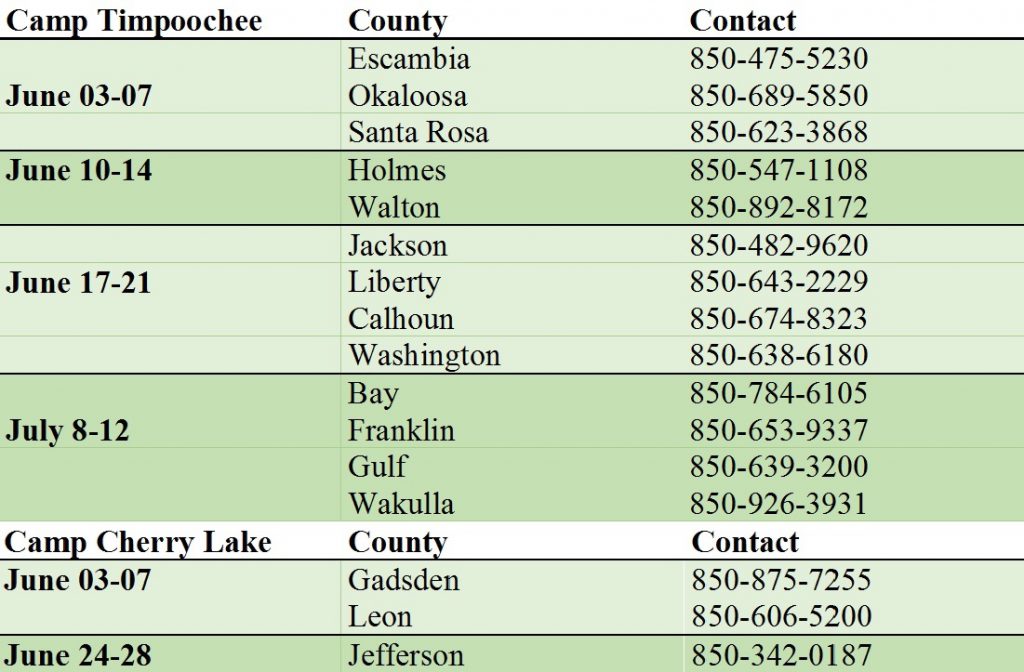
Who: Campers (8-13 years of age) & Counselors (14-18 years of age)
Where: Camp Timpoochee- 4750 Timpoochee Lane, Niceville, Florida 32578
Camp Cherry Lake- 3861 NE Cherry Lake Circle, Madison, Florida 32340
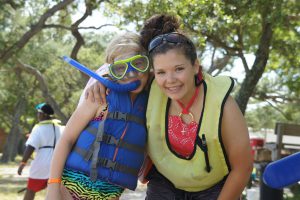
Youth volunteers, like our 4-H Camp counselors, are a great asset to the county 4-H program.
by Yolanda Goode | Mar 15, 2019

Are you physically or mentally running on E?
Are you racing “90 to nothing” in your daily life? until something forces us to hit the brakes or the emergency brake is applied. Instead of clearing our plates, we add sideboards onto them so that we can accept more.
We wear many hats outside of work such as a family member, caregiver, volunteer, student, etc. Some days we find ourselves in foul moods where we lack comprehension, patience, and focus. Is it because we are hangry (hungry + angry) or just plain ole tired? You’ve heard the saying; “you can’t squeeze blood from a turnip”… or is that a beet?…LoL, you get the point. How do we avoid the breakdown that can and will happen if we keep pushing ourselves without intentional refueling?
Here are several tips to help you stay fueled and refreshed:
- Block scheduling: I shared a photo of a tool that I use, but you use what works for you. The key thing is for you to understand where you can capture time for yourself to refuel.
- Rest: Sleep on a regular schedule and take breaks during the day.
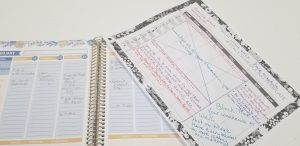
- Eat well: physically, mentally, emotionally, and spiritually.
- Have some fun: You are encouraged to have fun. Adulting is tough.
- Take lunch: Go visit a local library, museum, or sit in your car at a local park.
- Vacation: Plan for it, and take it. But leave some recovery time, so you are not rushing back to work the next day. Another option is weekend trips or a day-cations while kid(s) are at school.
- Nurture your hobbies: When was the last time you ____________?
- Guard your time: Once you’ve blocked it out, it’s yours. Don’t let others guilt you into giving it back.
Slowly implement some of these tips into your life, and remember an empty tank is just that. Empty. You will be more productive by taking care of you, and you’ll be better able to wear all those hats.
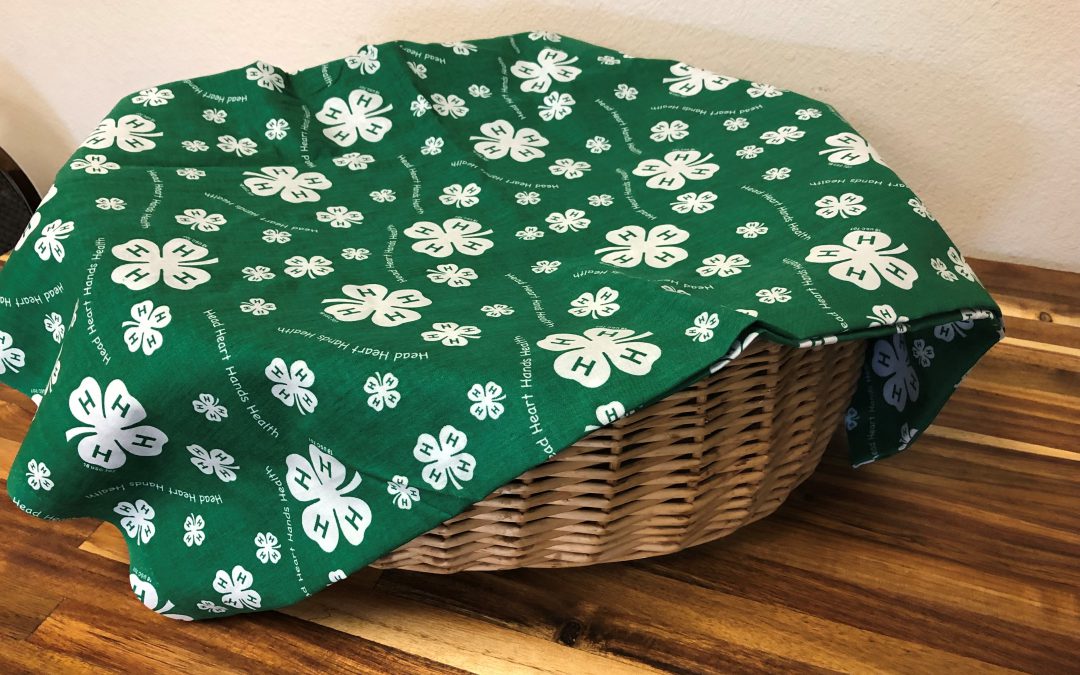
by Marie Arick | Mar 11, 2019
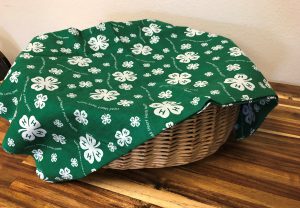
4-H Food Challenge Mystery Basket
Being creative in the kitchen…using a surprise set of ingredients…making a tasty dish…frequent watcher of The Food Network? Then the 4-H Food Challenge camp is the summer day camp for you!
Take a Sneak Peek
Here’s a sample list of possible ingredients in the Fruit & Vegetable category:
- 4 medium potatoes
- 1 cup carrots, sliced
- 1 cup of celery, sliced
- 1 ½ cups green bell pepper strips
- 1/3 cup onions, sliced
- 1 clove garlic, minced
- 1 tomato, cut into wedges
- 3 tablespoons of canola oil, divided
- ½ cup of water
- 2 tablespoons of low sodium soy sauce
- 1 ½ teaspoons of cornstarch
Any idea what you’d prepare? What would you name your dish?
Participants in the 4-H Food Challenge camp will work in teams with 3 to 4 members. Teams will be presented with:
- a food category
- a set of mystery ingredients
- 40 minutes to create a dish, prepare a presentation about their dish, and clean their work area
When time is up, teams will present their creation to a panel of judges describing their collaboration in creating the dish, food safety practices used by the team, how they worked together, and finally, a description of the dish including some nutrition information.
We all eat, so food safety and preparation are skills that we all need. 4-H Food Challenge campers will learn those skills along with nutrition knowledge, teamwork and presentation skills. Look for this day camp opportunity in your local UF/IFAS Extension 4-H program this summer, and join us in putting our skills to the test!
*The 4-H Food Challenge is loosely based on The Food Network show “Chopped” and adapted from the Texas 4-H Food Challenge Contest.
by Whitney Cherry | Mar 8, 2019
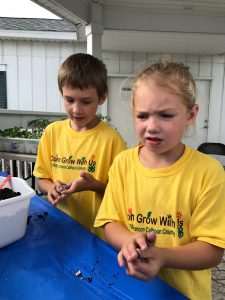
Wildflower seed bombs are a great indoor or outdoor project with unlimited potential for learning.
Wildflower seed bombs are the perfect project for kids itching to get outside. Even if you don’t have a green thumb or you don’t have outdoor space or the weather isn’t cooperating, you can make seed bombs that will help beautify roadsides, vacant areas and neighborhoods.
Give Them a Toss!
These little beauties don’t get their name from any explosive properties but from the fun you have “launching” them around your yard or neighborhood. As you toss them into places that aren’t frequently mowed, you beautify your neighborhood and provide an invaluable food sources for native Florida pollinators like bees, wasps, butterflies, and more.
Even though you may be more fond of some pollinators than others, there’s no doubt we need them all. Their pollination services are critical to fruit development in many of our fruiting crops. So if you like squash, cucumbers, melons, almonds and so much more, here’s what you can do to help:
Gather Your Materials
- Air-dry clay
- Wildflower seeds
- Potting Soil
Make Your Seed Bombs
- Pinch off a small amount of air-dry clay – enough to make a ball about the size of a bouncy ball or about 1″ diameter.
- Work equal parts seeds and soil into the clay and form it into a ball.
Amounts really are up to you. More seeds = more flowers.
But, too much soil will keep the ball from holding it’s shape. If this happens, add more clay and either have a bigger bomb, or divide it into two smaller bombs.
- Store them in a cool dry place and let them dry out completely in an air-tight container until you’re ready to spread some wildflower cheer.
- Now for the fun part! Toss them where you want flowers to grow.
Things to Consider…
- The air-dry clay acts as a binder only. It’s natural, non-toxic, and when wet, it will soften and allow the seeds to grow.
- Before storing in an airtight container, allow your seed bombs out to dry completely. Even a little moisture will allow the seeds to sprout.
- Be careful when throwing your seed bombs.
- Don’t hit people, animals, or other anything else with them – just the ground.
- Throw them where areas don’t get mowed very much. Some people throw them out along roadways or in abandoned lots. If these places are mowed regularly, they won’t last long if they even get to bloom.
- Get permission if you’re throwing them in public places.
Resources
Gardening is just one of the many Florida 4-H programs. To see what programs are available in your county, contact your local UF/IFAS Extension office, or contact your 4-H Agent about starting a gardening program in your county.
by Julie Pigott Dillard | Mar 1, 2019
 Registration opens today for the 2019 4-H Chick Chain project! This project teaches youth how to raise baby chicks to laying age using science-based best practices. At the end of the project, youth compete in a showmanship and skill-a-thon contest to test their knowledge and also exhibit their birds for judging and awards.
Registration opens today for the 2019 4-H Chick Chain project! This project teaches youth how to raise baby chicks to laying age using science-based best practices. At the end of the project, youth compete in a showmanship and skill-a-thon contest to test their knowledge and also exhibit their birds for judging and awards.
HOW DOES THE 4-H CHICK CHAIN PROJECT WORK?
Purchase or hatch your own chicks during the month of March. The number you choose to purchase or hatch is up to you, but we recommend that you begin with at least three chicks.
Chicks must be from the following breeds:
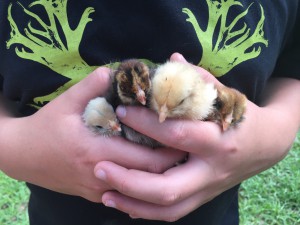
Chicken breeds have unique needs and personalities. Do some research before you choose your breed.
- Australorp
- Barred Rock
- Brahma
- Jersey Giant
- Leghorn
- Orpington
- Rhode Island Red
- Silky
- Welsummer
- Wyandotte
There is an orientation webinar and a hands-on workshop to get you ready for the show. Your 4-H Agent or project volunteer can also make a home visit to check up on your progress.
HOW DO I SIGN UP?
4-H Chick Chain is open to all youth ages 5-18 who are enrolled or enroll as new members in 4-H. Enroll now.
Registration opens March 1 and closes March 31 in 4honline.
Families can share a project, but each youth should be individually registered.
Members who participated in the 2018 4-H Chick Chain project can register as a returning production project.
REGISTRATION FEES:
- 2019 New Project: $20
- 2018 Returning Production Project: $10
To learn all about the project, read the 2019 4-H Chick Chain Youth Project Guide.
If you’re an adult with a love of poultry that you’d like to share with others, consider becoming a 4-H poultry project leader. Our poultry programs include 4-H Embryology in the Classroom, 4-H Chick Chain, and 4-H livestock clubs. Visit http://florida4h.org/volunteers to find out more. To learn more about 4-H in your county, contact your local UF/IFAS Extension Office.
Still have questions about 4-H Chick Chain? Contact project chair – Julie P. Dillard – juliepd@ufl.edu or call 850.638.6180.
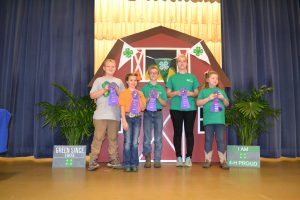
Best of Breed winners from the 2018 4-H Chick Chain.
by Yolanda Goode | Feb 22, 2019
Generosity is one of the four essential elements youth need for positive youth development. 4-H clubs should do at least one community service project a year as part of their plan of action. This benefits our high school students because most students need service hours as part of graduation requirements. But with all the “have-to-do’s” in life, service can become just a thing to check off and have no real value.
How can we help our 4-H youth get more value from service projects?
Use the Experiential Learning model (Do-Reflect-Apply) used by 4-H programs across the nation. Incorporating the reflect and apply portion of the model does take some effort, but it is not hard to do. If your club does many community service activities, choose which ones to incorporate all the steps of the Experiential Learning model.
How to take it deeper beyond just a thing to do:
Get buy in from youth concerning the service project(s) planned for the year.
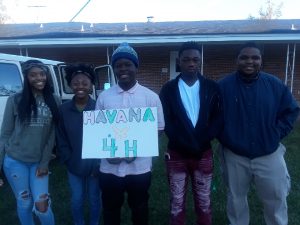
UF/IFAS Extension Gadsden County 4-H Club members out delivering Thanksgiving baskets to families in need.
Pre-activity – Have youth do a presentation related to the service project activity:
- Who we are helping: Details about the group/organization
- What type of service(s) will be done for the group
- How will our community service benefit this group/organization
Post activity – have a casual conversation:
- Enquire about how they felt about the service activity
- What was an ah-ha moment
- What did they find challenging
- What could we do differently for next project
- What is something you learned by doing this project that you could use in other areas of your life.
Here’s a great article in the Florida 4-H Volunteer Training Series that really breaks down the process. You can also give your local UF/IFAS Extension 4-H Agent a call for more help.
How can you keep up with the great things we’re doing in our 4-H extension district?
- LIKE the 4-H in the Panhandle Facebook page – @volunteeringinthepanhandle
- LIKE your county’s 4-H Facebook page
- SUBSCRIBE to the 4-H in the Panhandle blog
by Rachel Pienta | Feb 15, 2019
The 4-H Exchange Experience in the NW District

Sali and Gregor received a brief orientation to 4-H and life in the United States soon after their arrival.
Wakulla 4-H welcomed two international students via the Future Leaders Exchange Program at the beginning of September. The students, who are living with volunteer host families this school year, have become active 4-H members during their stay. Sali Polotov is from Tajikistan and is interested in studying geological science. Gregor Johanson is from Estonia and is interested in the performing arts. Both students attend 11th grade at Wakulla High School.
Eye Opening Experiences
Since their arrival, they have been part of the 4-H District III Council and attended Leadership Adventure Week where Gregor led a workshop on trust and communication.
During a recent interview with the 4-H Academic Year Program (AYP) FLEX students, Sali and Gregor reflected on their experiences at the midpoint of their year. Gregor shared it had always been a dream to study overseas. He saw an Instagram advertisement and decided to apply. He did not know about 4-H and learned about it after being accepted to the Academic Year Program. Since coming to the United States, he said has experienced some surprises. He was surprised by the American “addiction to fast and unhealthy food” and he has observed “that it seems to be more prevalent in rural areas.”
“There have been a lot of things that have surprised me, good things and bad things. Some of the good things include much friendlier and welcoming customer service, as well as a wider range of options for everything everywhere.”
– Gregor Johanson
Sali shared that he was motivated to come to the United States because he wanted to see the reality versus what was depicted in movies he had seen in Tajikistan. While Sali said that he knew nothing about 4-H before coming to Florida, he has enjoyed the opportunities to participate in 4-H clubs, special events and volunteer work.
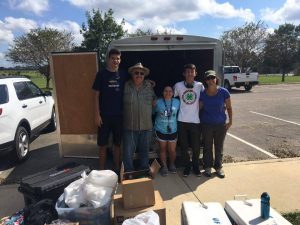
Sali Polotov joined other Wakulla 4-H members to deliver relief supplies to the NFREC office after Hurricane Michael.
One thing that surprised Sali about American life was how “American people love holidays. They do all of their best to spend an unforgettable moment.” Sali shared he has especially enjoyed his experiences volunteering in the aftermath of Hurricane Michael, snorkeling with manatees and celebrating Christmas with his host family.
Both young men are looking forward to an upcoming trip to Disney World and having more adventures with 4-H before their year in the United States concludes.
The Future Leaders Exchange Program (FLEX)
Since 1993, the FLEX Program has provided scholarships for high school students from Europe and Eurasia to spend an academic year in the United States while living with a family and attending an American high school. Florida 4-H partners with the FLEX program through the States’ 4-H International Exchange Programs. Students have opportunities to engage in both short-term summer programs and academic year exchange experiences. Nearly 60,000 youth and families have been positively impacted by international exchange through States’ 4-H programs since 1997.
The FLEX program is a competitive, merit-based scholarship program funded by the U.S. Department of State. Students gain leadership skills, learn about American society and values, and teach Americans about FLEX countries and cultures. The primary goal of the FLEX program is to improve mutual understanding and develop and strengthen long-term relationships between citizens of the United States and other peoples and countries. There are currently 17 countries that participate in the FLEX program: Armenia, Azerbaijan, Estonia, Georgia, Kazakhstan, Kyrgyzstan, Latvia, Lithuania, Moldova, Mongolia, Montenegro, Poland, Romania, Serbia, Tajikistan, Turkmenistan and Ukraine. Not all 4-H AYP students come to Florida through the FLEX program and students may come from other partner countries.
How to Get Involved with the 4-H AYP Program:
Families can become qualified to host an international student for the 10 month Academic Year Program by applying at https://states4hexchange.org. For more information, contact Georgene Bender, Florida 4-H AYP Coordinator, UF/IFAS Extension Faculty Emeritus – gmbender@ufl.edu.
For more information about this program or other 4-H programs in your county, contact your local UF/IFAS Extension Office.
Additional Resources:

by pmdavis | Feb 14, 2019
Making lotions and bath scrubs, practicing relaxation and doing yoga…doesn’t this sound like a great 4-H club program? Discover 4-H Spa and Relaxation Clubs are a great way to learn about homemade body products while learning relaxation techniques. Youth create a day at the spa by making lotions, soaps, scrubs and lip balms while learning methods to relax like tennis ball massages, creating a happy list, doing yoga and creating a zen garden. An added bonus is homemade products are a fraction of the cost of purchasing and make great gifts for friends and family.
Make your own Luxurious Bath Salts
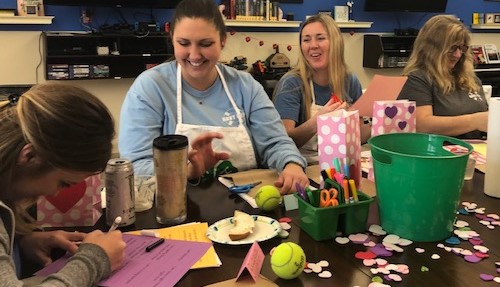
Naval Support Activity-Panama City staff learning how to making calm bags.
- ½ cup baking soda
- ½ cup powdered milk
- 1 cup sea salt
- 1 cup Epsom salt ( scented or plain)
- Use 3-5 drops fragrance oil designed for soaps or diluted essential oil for plain Epsom salt
- Mix ingredients
- Spoon the mixture into storage containers (wide mouth jars, bowls or zip style bags work well)
- Label your container with ingredients and direction for use – Pinterest has several cute label designs
Caution: Essential oils are very strong and can be a skin irritant if applied directly to your skin. National Association for Holistic Aromatherapy recommends diluting essential oils with a carrier oil: use 1 teaspoon of coconut, almond, olive, sunflower or jojoba oil with 2 – 12 drops of the desired essential oil. Then, mix 3-5 drops of the diluted oil to your bath salt mixture. Bath salts are generally safe for most when used properly, but you should talk to your doctor before using bath salts if you have medical conditions such as skin diseases, heart disease or diabetes.
How to Use Your Bath Salts: Fill your tub halfway with warm to hot water, and pour in about 1/2 cup (120 g) of bath salts. For a stronger concentration, you can always add more. If you prefer showers, take a handful and rub over desired area. Bath salts are great to exfoliate by removing dead skin cells leaving the skin smooth and fresh. Tired achy feet or hands? No problem! Add salts to warm water in a dishpan, and immerse your feet or hands and soak away the pain.

NSA-PC staff learning the 4-H Spa & Relaxation Curricula they will use in their 4-H programs.
For more information on 4-H and other programs like this, contact your local UF/IFAS County Extension Office, or visit Florida 4-H.
Are you an adult looking for ways to coach, teach and mentor youth? Contact the 4-H Agent in your county and enroll as a volunteer in 4-H Online. Volunteering not only strengthens the 4-H club, but also shows young people how to live with integrity, optimism, hope, determination, compassion, responsibility and resiliency – skills that will help them succeed in life.
Resource:
Discover 4-H Spa and Relaxation Clubs curriculum
by Julie Pigott Dillard | Feb 8, 2019
 Well’s FRM was one of my favorite places to go with my dad when I was a little girl…especially when baby chicks arrived. With spring right around the corner, local feed stores will be getting shipments of baby chicks soon. Have you thought about raising baby chicks but are unsure how to? Then join us in the 4-H Chick Chain project!
Well’s FRM was one of my favorite places to go with my dad when I was a little girl…especially when baby chicks arrived. With spring right around the corner, local feed stores will be getting shipments of baby chicks soon. Have you thought about raising baby chicks but are unsure how to? Then join us in the 4-H Chick Chain project!
4-H Chick Chain teaches youth how to raise baby chicks to laying age using science-based best practices. At the end of the project, youth compete in a showmanship and skill-a-thon contest to test their knowledge and also exhibit their birds for judging and awards.
HOW DOES THE 4-H CHICK CHAIN PROJECT WORK?
You’ll purchase or hatch your own chicks during the month of March 2019. The number you choose to purchase or hatch is up to you, but we recommend that you begin with at least three chicks.
Chicks must be from the following breeds:

Chicken breeds have unique needs and personalities. Do some research before you choose your breed.
- Australorp
- Barred Rock
- Brahma
- Jersey Giant
- Leghorn
- Orpington
- Rhode Island Red
- Silky
- Welsummer
- Wyandotte
The 4-H Chick Chain is designed to take you step-by-step through the process of raising your birds to healthy laying age.
There is an orientation webinar and a hands-on workshop to get you ready for the show you’ll attend during the summer. Your 4-H Agent or project volunteer can also make a home visit to check up on your progress.
HOW DO I SIGN UP?
4-H Chick Chain is open to all youth ages 5-18 who are enrolled or enroll as new members in 4-H. Enroll now.
Registration opens March 1 and closes March 31 in 4honline.
Families can share a project, but each youth should be individually registered.
Members who participated in the 2018 4-H Chick Chain project can register as a returning production project.
REGISTRATION FEES:
- 2019 New Project: $20
- 2018 Returning Production Project: $10
To learn all about the project, read the 2019 4-H Chick Chain Youth Project Guide.
If you’re an adult with a love of poultry that you’d like to share with others, consider becoming a 4-H poultry project leader. Our programs include 4-H Embryology in the Classroom, 4-H Chick Chain, and 4-H livestock clubs. Visit http://florida4h.org/volunteers to find out more. To learn more about 4-H in your county, contact your local UF/IFAS Extension Office.
Still have questions about 4-H Chick Chain? Contact project chair – Julie P. Dillard – juliepd@ufl.edu or call 850.638.6180.

Best of Breed winners from the 2018 4-H Chick Chain.


















